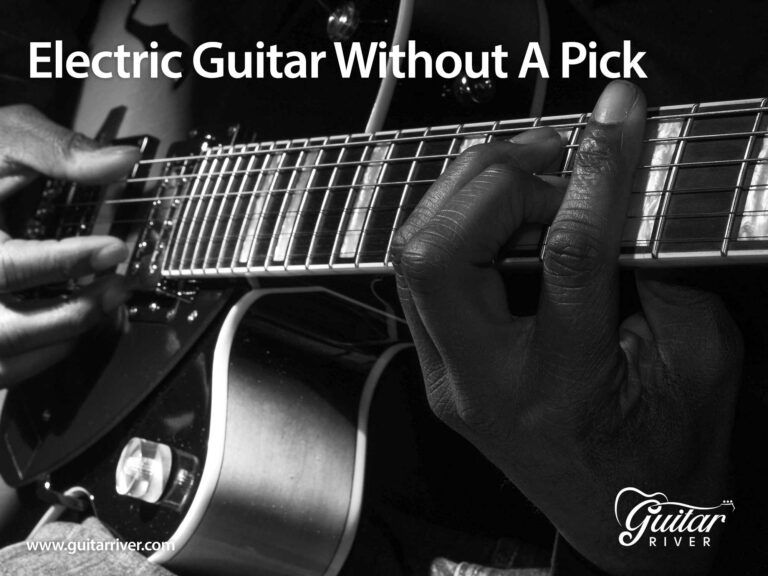Guitar River is reader-supported. We may earn a commission when you make a purchase using the links on our site.
Learn more.
Playing An Electric Guitar Without A Pick: Fingerstyle Explained

We’ve all heard the fingerstyle guitar in classic songs like Simon & Garfunkel’s “Scarborough Fair / Canticle” and Fleetwood Mac’s “Landslide.” With fingerstyle guitar, you play the strings by plucking them with your fingers rather than striking them with a pick. Fingerstyle is a technique usually associated with classical and acoustic guitar. But what about fingerstyle with the electric guitar? Is playing the electric guitar without a pick a bad idea?
Playing the electric guitar without a pick (fingerstyle) is a matter of personal preference and musical style. Most electric guitar players learn to play with a pick at first. Fingerstyle is an advanced technique mainly used with classical and acoustic guitar. However, some accomplished electric guitar players prefer fingerstyle technique.
Keep reading as we explore the pros and cons of playing an electric guitar without a pick, how to get started, and well-known guitarists who use fingerstyle technique with the electric guitar.
Is It Time To Ditch The Pick?
Pros: You Don’t Need A Bass Player!
First, let’s take a look at some of the advantages of playing electric guitar without a pick.
By using just your fingers, you can play simultaneous notes on different strings more easily. Plucking two or more strings at the same time is more precise than playing those strings with a pick, especially while muting other strings.
A bass part can be established independently with the thumb. This will be more common in country music, blues, and folk songs. And you will see some jazz players creating a strong rhythm or bass line as part of their fingerstyle technique.
While playing an arpeggio is certainly possible with a pick, in some ways, it’s easier to do with fingerstyle technique. If you learned any classical pieces, you will be familiar with playing arpeggios using your picking fingers.
Musicians can create an expressive and unique sound without a pick by developing their picking-hand technique.
Using a guitar pick or your fingers are two ways of approaching the instrument that produce two different types of sound.
Authenticity
Playing an electric guitar using fingerstyle technique can give songs of certain genres a more authentic sound:
- You may opt to skip the pick for a lot of folk, country, blues, and jazz as playing with fingerstyle technique may sound more at home in these genres.
- On the other hand (pun intended), you don’t necessarily want to play a blistering rock solo without a pick.
Using the right tools for the job is essential in mastering your craft.
Playing electric guitar without a pick develops finger independence and muscle memory skills with your picking hand.
Finger independence is critical when playing guitar. With your fretting hand, you need to build your finger strength and independence in order to play scales, chords, and riffs effectively.
With your picking hand, developing finger independence allows you to play arpeggios, chords, rhythm, and bass lines.
Creating some independence between your fingers and thumb takes some practice but is worth learning if you want to master fingerstyle guitar.
Through practice, you can develop muscle memory so that your fingers know where to go and what to do automatically. This leads to proficiency and opens the door to more technical and expressive playing.
Cons: Fake Nails, Gross
Now that we know the pros, let’s take a look at some disadvantages of playing an electric guitar without a pick.
When playing with your fingers, repetition of a single note and phrases on a single string is more difficult. With alternate picking using a pick, it’s easier to play fast solos than it is just with your fingers.
You need to maintain your fingernails at a consistent length so that your picking technique is dependable. And heavier gauge guitar strings can cause damage to your nails. Some players even use fake nails!
Without practice and refinement, your sound can be inconsistent when playing without a pick. Your fingers may be inconsistent in their attack, and varying fingernail lengths can cause different sounds.
What if you aren’t playing the lead? Well, using a pick will make rhythm guitar much easier. If you are playing rock or pop music, you will likely find using to pick to be easier for rhythm guitar parts.
Since a pick is harder than your skin, notes will sound louder when struck with a pick rather than your fingers. However, your fingernails can be just as loud as a pick.
Fingerpicks
Keep in mind that picks come in a range of materials, thicknesses, and shapes. The variety allows you to adjust your tone, and use specific picks for certain applications. For example, you might want a thinner pick for strumming and chords, and a heavier pick for speed and technical solos.
And you may not know it–especially as an electric guitar player–but you can also find picks designed to go on your fingers. This solves the problem of inconsistent fingernail length and wear and tear on your fingers and nails. These fingerpicks are made from metal or plastic.
Often, new electric guitarists will find themselves using their fingers over a pick because it’s easier at first. However, what’s easy is not necessarily always the best method. A good player is well-versed in all aspects of their instrument.
Knowing electric guitar picking techniques gives you the freedom to choose the right method for the style of music you are playing. The last thing you want to do is get stuck in a box that doesn’t quite fit the genre.
Playing With A Pick Vs. Playing With Your Fingers (Fingerstyle)
There isn’t a right or wrong way to play the guitar. Just as there is no right or wrong route to take to get home from work, they both get you to your destination.
The only difference is how you get there. When choosing between a pick and fingerstyle, the answer is simple, do what works for you. Consider your style, song genre, and how you want your guitar to sound.
There’s a third option we haven’t mentioned yet–hybrid picking.
Hybrid picking is a style of playing that uses both your fingers and a pick, rather than one or the other. Hybrid picking may be an advanced technique, but it’s a great way to have a versatile sound and introduce some freedom into your playing.
It’s important to acknowledge your strengths and don’t dwell on your weaknesses. Music is a creative space. There is room for multiple different approaches when it comes to electric guitar.
If you don’t feel confident yet in fingerstyle, that doesn’t mean you are stuck playing with a pick forever. Many of the greatest guitar players do not use a pick. Let them be your guide and learn from the masters.
How To Play Electric Guitar Without A Pick
While not specific to the electric guitar, here is a great introduction to fingerstyle guitar from Tommy Emmanuel via Reverb.
Tommy perfectly demonstrates finger and thumb independence in that video. He creates a bassline with his thumb on the E, A, and D strings, while filling out the chord on the G, B, and E strings with his first three fingers. His pinky is planted on the guitar for stability.
There are many different genres and playing styles to consider when playing an electric guitar without a pick…but that’s another blog post in itself!
Today, we will take a look at the basics to get started. Playing fingerstyle electric guitar boils down to focusing on what your strumming hand is doing. For the most part, your fretting hand technique will remain the same.
What You Will Need
- An electric guitar
- A song
- A desire to learn
Which Finger Belongs To Each String?
First, it’s essential to know which string is assigned to each finger.
With fingerstyle, the bottom three strings, or the bass strings, are governed by your thumb. The top three strings, or the treble strings, are governed by your first three fingers. As Tommy demonstrates above, your pinky finger is planted for stability.
This will vary depending on the genre and the player’s style. We are examining a traditional fingerstyle approach here as opposed to a classical guitar technique, or a percussive technique in the style of Michael Hedges.
Here’s the assignment of your fingers and strings (remember the string numbers, we will use them later):
| Guitar String | String Number | Finger Assignment |
| E | 6 | Thumb |
| A | 5 | Thumb |
| D | 4 | Thumb |
| G | 3 | Index |
| B | 2 | Middle |
| E | 1 | Ring |
Playing A Fingerstyle Rhythm
Now that you have your fingers associated with the proper strings, it’s time to learn a few basic patterns of fingerpicking.
Below are some finger-picking patterns that explain when each string is played. Here’s where those numbers come in!
Keep in mind that (with some chords), your root note will be the E string, and with some, it could be the A or the D string. So be sure you play the right root note for the chord.
Basic Fingerstyle Patterns
A basic starting pattern is Thumb, Index, Middle, Ring, repeat. This creates a rolling, easy chord pattern. You can try it with a C chord, and your thumb starting on the fifth string. Also try a D chord, with your thumb starting on the fourth string.
To add some variety, try the same pattern, but alternate your thumb on the repeat. For example, try 5, 3, 2, 1 followed by 4, 3, 2, 1. You can play this with a C chord. But experiment, and try some other chords as well.
Another approach is to vary the bass note again with a constant treble note. For example, using a G chord, play the bottom three notes while alternating with the first string. Using the string numbers for notation, it would look like this: 6, 1, 5, 1, 4, 1, repeat.
If the root of the chord is on the fifth string such as with a C chord, the pattern would be 5, 1, 4, 1, 3, 1, repeat.
Admittedly, these patterns are a little basic, but you have to start somewhere. I recommend checking out some fingerstyle tutorials on YouTube or through an online guitar course. It may help to have a song in mind in order to learn from the pros.
Do Any Famous Guitarists Play Without A Pick?
Even though playing electric guitar with a pick is more common, some famous guitar players skip the pick altogether. It’s possible to achieve a very expressive and dynamic sound playing electric guitar without a pick.
Many guitar players preferred the sound of their electric guitar without a pick and built memorable careers on just that. Here are a few of these trendsetters to get you thinking…
Lindsey Buckingham
As one of the top guitar players of his generation, the lead guitarist of Fleetwood Mac used his iconic fingerpicking method in some of their most loved songs.
Check out the intro to “Rhiannon,” where Lindsey showcases his unique fingerpicking style. You can hear the bassline played on the guitar using his thumb, while his fingers pick out the melody of the song.
While Buckingham notes that he sometimes uses a pick, especially in the studio, he naturally evolved his fingerpicking playing style from a young age. He was influenced by players like Chet Atkins and Scotty Moore as well as classical guitar music.
As folk music became entwined with rock in the 60s and 70s, fingerstyle became a natural choice for Buckingham.
Buckingham’s style is somewhat understated when compared to pyrotechnic players like Eddie Van Halen. Still, his guitar playing is masterful, and as one of the greatest, he is appreciated by both guitar players and music fans alike.
Mark Knopfler
One of my favorite guitarists, Mark Knopfler pioneered fingerstyle on the electric guitar as the frontman for Dire Straits. Knopfler established a solo career after Dire Straits and his distinctive playing can be heard on songs from the early days of his career to his current solo albums.
Knopfler’s style is incredibly lyrical and soulful. Just listen to “Brothers in Arms.” From the mournful intro to the solo, the song is highly evocative thanks to Knopfler’s playing. Combining volume swells and delicate phrases, the guitar becomes another voice in the song.
The song “Sultans of Swing” demonstrates Knopfler’s light touch and fingerstyle fluency. Knowing that he plays without a pick makes you appreciate his style even more. The outro solo to “Sultans of Swing” is surprisingly quick and agile, especially considering he plays it fingerstyle.
Jeff Beck
One of the most iconic guitar players of all time, Jeff Beck primarily plays the electric guitar fingerstyle. He dropped the pick in the 1980s and developed a unique and unmistakable style with just his fingers.
Beck is a fantastic example of the possibilities available when playing an electric guitar without a pick. His technique involves using his thumb to pluck the strings while keeping his ring finger on the volume and his pinky on the whammy bar.
Beck notably plays a Fender Stratocaster making frequent use of the whammy bar. Check out “Where Were You” to hear his dynamic use of the tremolo to create melodic phrases. You can hear his volume swell technique on this song as well.
As a side note, his guitar tech should be thanked. While most tremolo-heavy guitar players use locking Floyd Rose systems, Beck manages to do what he does on a Strat. The average player would have issues keeping it in tune!
Beck is a true guitar legend who developed his electric guitar style and sound without a pick. On why uses his fingers instead, Beck remarked that when playing with a pick, the other fingers are redundant. He wanted to use all available digits instead of letting them sit idle.
Albert King
Albert King is rightly known as one of the “Kings of the Blues,” along with B.B. King and Freddie King. Despite sharing the same last name, these blues greats were not related to one another.
As a left-handed guitarist, King played a standard right-handed guitar upside down. Set up for a right-handed player, the low E string was towards the bottom of the neck, and the high E was at the top.
In some ways, that string arrangement makes more sense with the low strings physically lower than the high strings. To add to this unconventional arrangement, King used alternate tunings such as C, B, E, G, B, E, and C, F, C, D, A, D.
King primarily used his thumb to pluck the strings, with the addition of his first finger at times. He started playing without a pick after dropping it too many times while playing. King had no problem creating deeply expressive and influential blues music using his fingers alone.
Wes Montgomery
Wes Montgomery was a renowned American jazz guitarist regarded as one of the most influential guitarists of the 20th century. His playing stands out for his use of octaves and chords. His solos progressed from single-note melodies to octaves, and then to full chords.
Reportedly, Montgomery started playing with his thumb in order to keep the peace. He worked in a factory job at the start of his career and didn’t want to disturb his neighbors when practicing at night. He opted to play quietly with his thumb.
Ultimately, he may have been able to achieve such speed and fluency in part due to his thumb. According to the lore, Wes Montgomery had a double-jointed thumb allowing him to play with a speed that others would find unattainable.
Montgomery began playing a tenor guitar at an early age, later switching to a six-string guitar and emulating the sounds of Charlie Christian. Montgomery’s use of his thumb while playing the electric guitar created a soulful, jazzy sound that was unattainable with a pick.
Derek Trucks
Derek Trucks started his career as a child prodigy and became an accomplished guitarist as an adult. Much like the great Duane Allman, Derek is known for playing slide guitar accompanied by a finger-picking style.
Not to mention, Derek Trucks joined the Allman Brothers Band in 1999, which is equivalent to becoming rock and roll royalty.
Check out the song “This Sky” off the Songlines album for a sampling of his expressive playing. The light melody in the intro hints at his interest in Indian classical music. He continues these themes in the slide guitar solo, while effortlessly blending styles with Southern rock riffs that would be at home in an Allman Brothers song.
Steve Hackett
As the lead guitarist for Genesis, Hackett brought a lot to the table, except a pick.
In an interview with Hackett at Premier Guitar, he states that he is pretty bad with a pick and actually makes many mistakes when using one.
This is from the man whose two-handed tapping technique influenced Eddie Van Halen in the 1970s–a technique that is much easier to do if you ditch the pick.
–
We have just scratched the surface of famous guitar players that play electric guitar without a pick. Do some research on your own, and find the players that speak to you. Learn from the greats, and determine if playing electric guitar with a pick will work for you.



